Bikaner Travel Guide: 2-Day Itinerary, Forts, Food & Desert Gems
Discover Bikaner in 2 days! Explore Junagarh Fort, Rampuria Haveli, and Karni Mata Temple, indulge in Bikaneri food, shop local crafts, and enjoy a sunset at Raisar Sand Dunes. Your complete Rajasthan travel guide.

Bikaner Travel Guide – A 2-Day Itinerary of Forts, Food & Desert Magic
Two Days, One Desert Gem – Unfolding the Palaces, Temples, and Timeless Trails of Bikaner
Bikaner Travel Guide – Why This Desert City Deserves More Hype
When travelers plan a trip to Rajasthan, a few names usually steal the spotlight—Jaisalmer’s golden dunes, Jaipur’s royal palaces, Udaipur’s serene lakes, Jodhpur’s blue streets, and Pushkar’s spiritual charm. But hidden among these giants is Bikaner, a desert city that truly deserves a place on every traveler’s list.
Most people recognize Bikaner for its famous snacks and sweets—thanks to big brands like Bikaji, Bikanerwala, and Bhikharam Chandmal. Others know it for the intriguing Karni Mata Temple (the famous “rat temple”). But beyond these well-known images lies a treasure trove of heritage forts, cenotaphs, camel safaris, and cultural experiences that remain surprisingly underrated.
Updated on: 14th, July 2025
Explored on: Dec' 2023
When I first decided to visit Bikaner, the reactions I got were predictable—most wondered why I was skipping the “popular” cities. Honestly, I had the same expectations. But once I arrived, Bikaner surprised me with its breathtaking palaces, intricate architecture, vibrant bazaars, and a royal legacy that feels more alive here than in many other Rajasthani cities.
So, if you’re looking for an authentic desert experience away from crowds, let me take you on a two-day itinerary through Bikaner—where heritage whispers through narrow lanes, flavors dance on your tongue, and dunes glow under a desert sunset.
This isn’t just another trip—it’s a travel rhyme written across the Thar desert. Come trace it with me.
Table of Contents
How to Reach Bikaner – Road, Rail & Air
Wondering how to reach Bikaner, the desert jewel of Rajasthan? Whether you’re planning a road trip, catching a train, or flying in, getting here is easier than you think.
By Road – Scenic Highways to the Desert City
Bikaner lies around 330 km northwest of Jaipur and is well-connected by highways to Delhi, Jodhpur, and other major Rajasthan cities. The drive is smooth and scenic, taking you through rustic villages, desert plains, and colorful roadside dhabas. Whether it’s a weekend road trip from the capital or a detour from another royal city, the journey is as rewarding as the destination.
💡Travel Tip: If you’re driving from Jodhpur, consider stopping at Mandore or local desert villages for an offbeat experience.
By Train – Rolling Into Bikaner by Rail
Bikaner is well-connected by Indian Railways, with regular trains from Delhi, Jaipur, Jodhpur, and smaller towns of Rajasthan. The city has two main railway stations— Bikaner Junction (centrally located) and Lalgarh Junction (6 km away). Trains are a convenient, affordable, and comfortable way to reach this desert city.
💡Travel Tip: If you’re coming by train during winter, book tickets early as Bikaner sees a surge of visitors for the famous Camel Festival in January.
By Air – Flying Close to the Thar
Flying into Bikaner is now simpler, thanks to Nal Airport, just 15 km from the city center. Under the UDAN scheme, there are direct flights from Jaipur and Delhi. Alternatively, you can fly into Jodhpur Airport (251 km away) and enjoy a road trip across the desert plains to reach Bikaner.
💡Travel Tip: If you land at Jodhpur Airport, you can combine your trip with a visit to Mehrangarh Fort and then continue to Bikaner by road.
Best Time to Visit Bikaner
Planning a trip to Bikaner? Choosing the right season can make all the difference to your desert experience.
Winter (October to March) – Peak Season
The best time to visit Bikaner is during winter, when the weather is cool, pleasant, and perfect for exploring Junagarh Fort, Devi Kund, and the Raisar dunes. Days are sunny yet comfortable, making it ideal for sightseeing and camel safaris. January is extra special as the city comes alive with the Bikaner Camel Festival, a cultural celebration of music, dance, and camel parades.
💡Travel Tip: Carry light woolens for evenings, as desert nights can get surprisingly chilly.
Monsoon (July to September) – Offbeat Charm
The monsoon brings light showers, painting the desert in fresh hues. While rain is not heavy, it can make the desert sands cooler and more refreshing. This season is great if you prefer fewer crowds and a calmer atmosphere.
💡Travel Tip: Pack sturdy footwear, as sudden showers may leave the lanes around local markets slightly muddy.
Summer (April to June) – Extreme Heat
Summers in Bikaner are scorching, with temperatures rising up to 45–46°C. Sightseeing during the day can be challenging, and this season is generally best avoided unless you’re accustomed to desert heat.
💡Travel Tip: If you must travel in summer, plan early morning visits to forts and temples, stay hydrated, and book a stay at a heritage haveli with good ventilation or air-conditioning.
Where to Stay in Bikaner
Whether you’re a budget traveler, a heritage lover, or someone looking for a luxurious escape, Bikaner offers a variety of stay options — from heritage havelis to modern hotels and cozy guesthouses.
Heritage Stays
Hotel Bhanwar Niwas – Housed in one of the famous Rampuria Havelis, this heritage property lets you experience the royal charm of Bikaner. The intricately carved interiors and traditional décor make it feel like stepping back in time.
Gajner Palace – Located slightly outside the city, this former royal hunting lodge offers palace-style rooms, a serene lake, and sprawling gardens. Perfect for travelers who want a luxurious, royal experience amidst history.
Luxury Hotels
Lalgarh Palace - Grand Indo-Saracenic marvel built by Maharaja Ganga Singh, this heritage hotel offers sprawling courtyards, vintage interiors, and a true royal stay experience in Bikaner.
Narendra Bhawan – Former home of Bikaner’s last Maharaja, this boutique hotel beautifully blends royal heritage with modern luxury. Eclectic interiors, fine dining, and curated experiences make it one of the best places to stay in Bikaner.
Budget & Mid-Range Stays
Guesthouses and budget hotels near Kote Gate and Lalgarh Palace offer comfortable accommodations at affordable prices. These are great for solo travelers, small families, or anyone looking for convenient access to the city’s main attractions.
💡Travel Tip: If you plan to visit during the Camel Festival or peak winter months, it’s best to book your stay in advance, as Bikaner gets especially busy. Bikaner offers accommodations for every type of traveler—from heritage havelis to budget-friendly guesthouses.
Oh, Bikaner, a treasure untapped,
With stories woven, in time entrapped.
Your name rings with treats so sweet—
Bhujia is crunchy, Rasgullas are a treat.
A desert land, yet hues so bright,
Bazaars that gleam in golden light.
Echoes of history, strong and tall,
Forts and havelis—grandeur calls.
Camels march with jewels rare,
Graceful strides through desert air.
Temples whisper tales of old,
Where even rats in faith behold.
With dune bashing to folk dances bright,
With mighty kings and hearts so light.
Oh, Bikaner, so bright, so true,
Forevermore, I cherish you!


Bikaner Itinerary Day 1 – Heritage, Food & Forts in Bikaner
Your first day in Bikaner is all about immersing in the city’s royal soul—wandering through heritage-filled lanes, savoring iconic Bikaneri street food, tracing stories in ancient temples, exploring the majestic Junagarh Fort, and ending the evening in bazaars that buzz with colors, crafts, and the irresistible aroma of fresh bhujia.
Rampuria Haveli – The Crown Jewel of Bikaner
The first rays of the sun paint Bikaner in hues of gold, and that’s your cue to step out and explore. The city is still stretching awake, the air is crisp, and the bylanes hum with the soft echoes of morning life. This is the perfect time to visit the crown jewel of Bikaner tourism—the Rampuria Haveli.
Tucked away in the narrow streets of the old city, this cluster of nine heritage havelis in Bikaner stands as a testament to royal grandeur. Built from rose-tinted Dulmera sandstone, the Rampuria Havelis carry the whispers of a bygone era—where intricate carvings, majestic facades, and exquisite frescoes tell stories of opulence and artistry. Every corner here is a photographer’s delight; a place where history and elegance intertwine effortlessly.
As the day unfolds, the lanes start bustling with locals and curious travelers, but in these early hours, you can wander undisturbed, soaking in the grandeur. You could easily spend two to three hours here, losing yourself in the mesmerizing details of the Rajasthani architecture and capturing frames that feel straight out of a fairytale.
For those who wish to experience Rampuria Haveli from the inside, Hotel Bhanwar Niwas—one of the most famous havelis—offers a stay unlike any other. Run by the Rampuria family, this heritage hotel in Bikaner lets you step back in time, with regal interiors and timeless charm. Staying here isn’t just about luxury—it’s about immersing yourself in the soul of Bikaner. If heritage stays fascinates you, you’ll also love the havelis of Jodhpur, where similar grandeur blends with the Blue City’s vibrant culture.
💡Travel Tip: If you plan to stay at Hotel Bhanwar Niwas, book well in advance, as heritage rooms are limited and in high demand among cultural travelers.
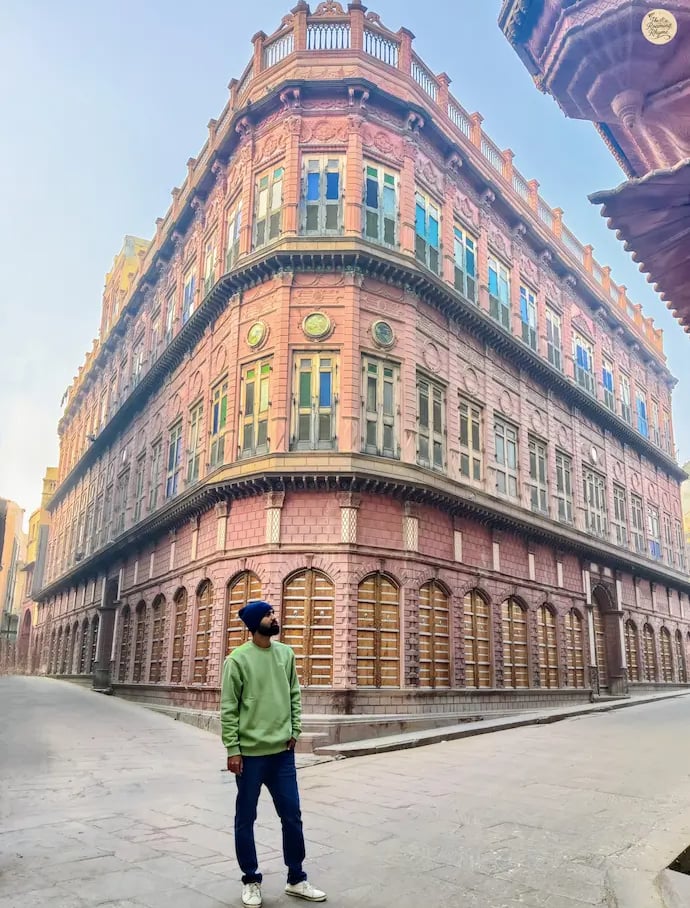

Exploring the grand Rampuria Haveli—a heritage gem of Rajasthan’s merchant era.
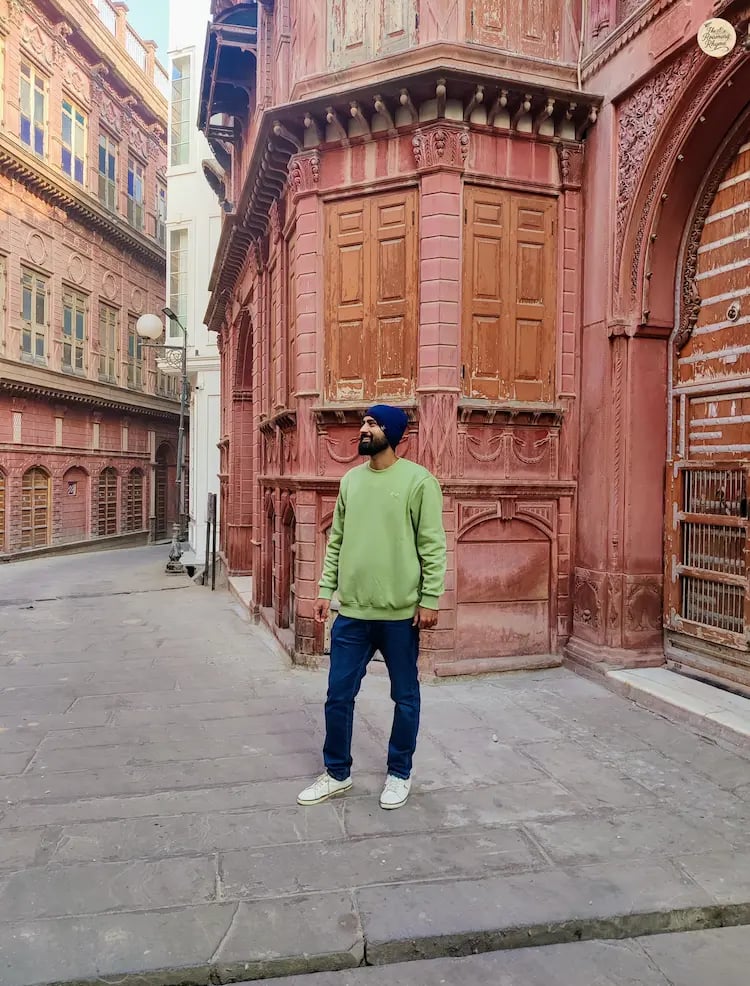

Rampuria Haveli—a marvel of architecture and artistic beauty in red sandstone.
A Heritage & Food Walk Through the Heart of Old Bikaner
After soaking in the grandeur of Rampuria Haveli, step into the maze-like lanes of old Bikaner. This isn’t just a walk—it’s an experience, a journey through the city’s soul where architectural heritage blends seamlessly with irresistible street food and the warmth of its people.
Begin your heritage trail at Rampuria Haveli, moving toward Teliwara Chowk, then through Mawa Patti and Chai Patti. Along the way, admire the sandstone artistry of Kothari Haveli and Sonawat Haveli, their intricate carvings echoing Bikaner’s glorious past.
Street Food Icons of Old Bikaner
Manka Maharaj Rabri Wale – Famous for their rich, creamy Rabri, a dessert that defines indulgence.
Birja Maharaj – Stop here for a perfectly crisp Samosa or the syrup-soaked sweetness of Ghewar.
Juniya Maharaj Kachori Wale – Don’t miss their unique Kachori with Pakoris, a flavor found only in Bikaner.
Graduate Kanji Vada – Cool off with their tangy, refreshing Kanji Vada, a favorite during hot afternoons.
Malchand Fini Wala – End on a sweet note with the delicate Kesariya Fini, saffron-infused and melt-in-mouth.
With your heart full of flavors and your soul enriched by history, conclude your walk at the serene Laxmi Nath Temple, one of the oldest temples in Bikaner—a perfect pause after this feast of heritage and taste.
💡 Travel Tip: Start this walk in the late morning or early evening, when food stalls are at their best and the soft golden light makes the havelis glow. Wear comfortable footwear—the narrow lanes are best explored on foot.
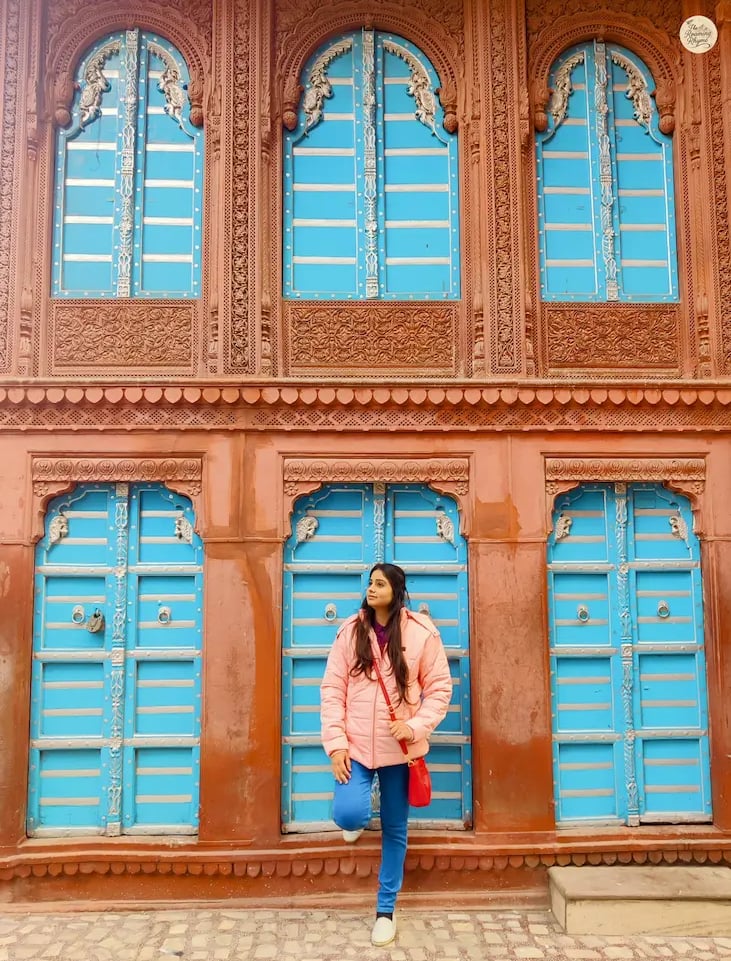

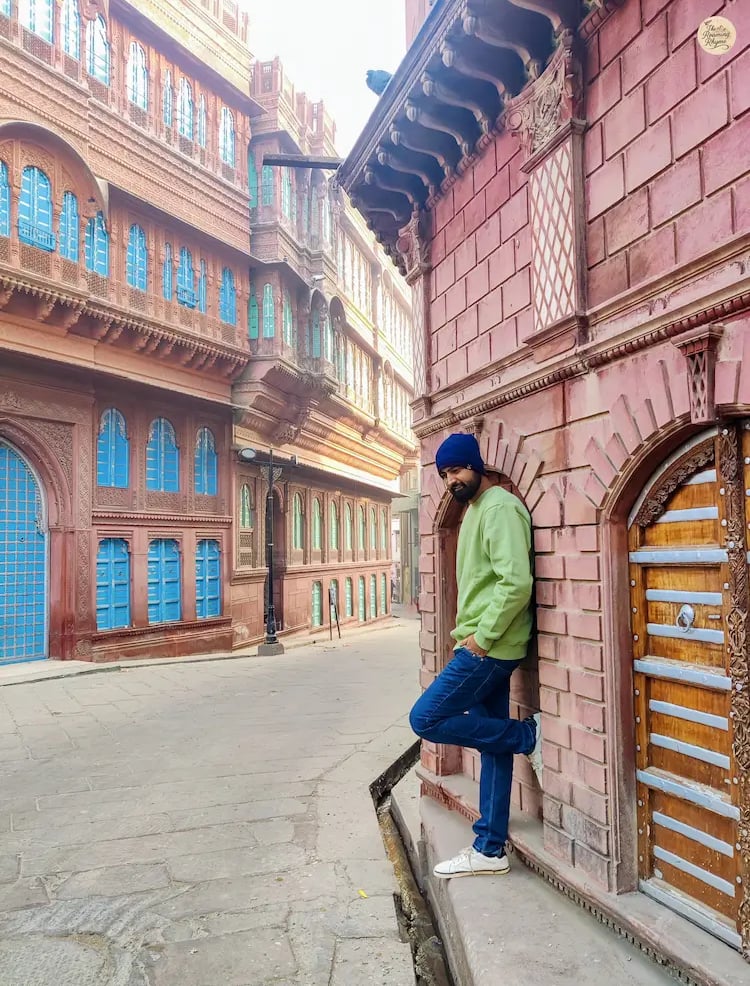

Traditional Bikaneri haveli with arched doorways and wooden balconies.

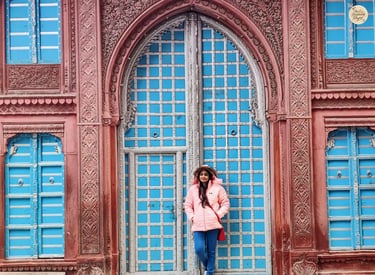
Strolling past historic havelis in Bikaner — where heritage lives in every carved door and window.
Narrow alley lined with grand havelis in the old city of Bikaner.
Temples of Bikaner – Shri Laxminath & Bhandasar Jain Temple
As your heritage and food walk nears its end, step into the calm embrace of Shri Laxminath Temple, a serene retreat from the lively chaos of old Bikaner. Dedicated to Lord Vishnu and Goddess Laxmi, the temple enshrines the deities in a divine embrace. Crafted from pristine marble and red sandstone, it radiates simplicity and grace, while the intricately carved silver doorway adds a touch of ethereal beauty.
Not far from here stands another architectural masterpiece—Bhandasar Jain Temple, an ode to devotion and artistry. Commissioned by Seth Bhanda Shah, this temple surprises you with its contrast: a simple bi-chrome exterior that opens into a world of vivid paintings and frescoes inside. Almost every wall is alive with depictions of Tirthankaras, Acharyas, floral motifs, and Bikaner’s cityscapes, turning the temple into a living gallery of faith and culture.
These temples, much like the intricate shrines of Khajuraho and the cenotaphs of Orchha, reflect the deep connection between art and spirituality that defines India’s heritage.
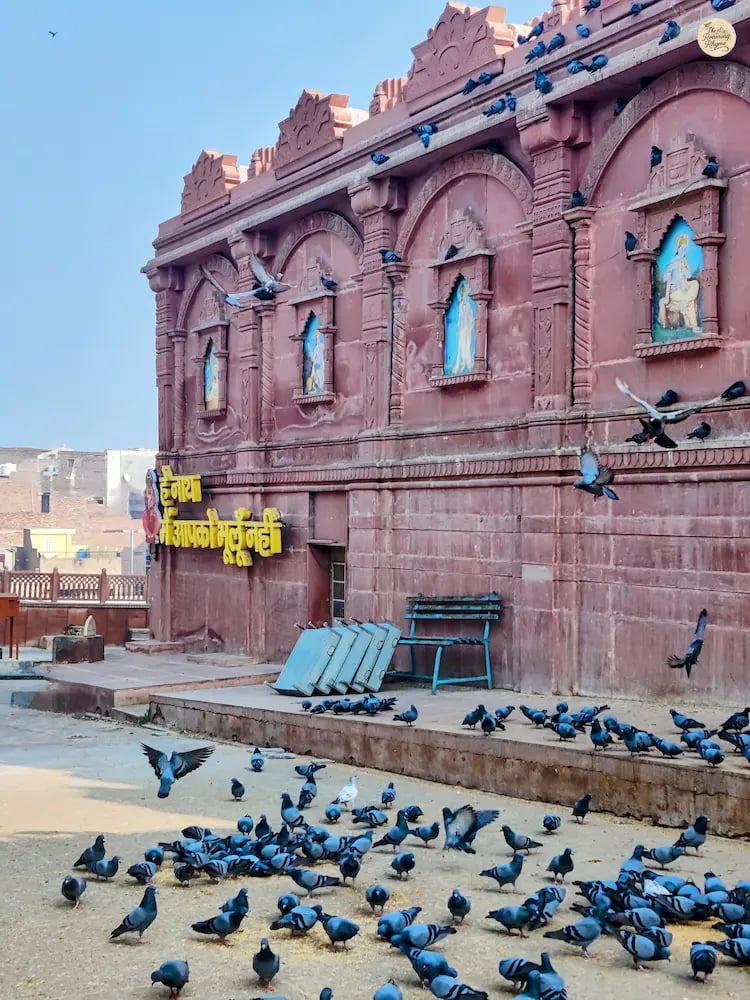

Early morning outside Lakshminath Temple—capturing the calm of this ancient spiritual site.
Have Lunch with a Rajasthani Thali
Before diving into the grandeur of Junagarh Fort, fuel up with the rich flavors of Rajasthan. A hearty Rajasthani thali is the perfect way to begin your afternoon. On your way from the old city to the fort, stop by Jeeman, a quaint eatery known for serving authentic local Bikaneri cuisine.
If you prefer a meal with a view, Gallop’s, located just outside the fort, offers a charming glimpse of Junagarh Fort’s majestic facade as you dine. For those already inside the fort complex, Prachina Café, tucked near the parking area, provides a relaxed atmosphere with great food and a picturesque outlook of the fort walls—ideal for a short pause before exploring history.
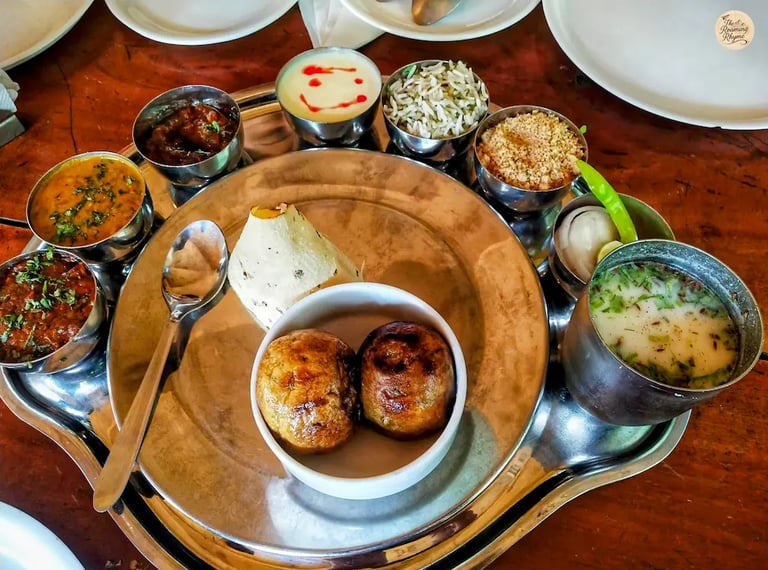

Delicious Rajasthani thali featuring dal baati churma, gatte ki sabzi, and more — a must-try in Rajasthan.
Whispers of Royalty – Junagarh Fort Bikaner
After savoring a hearty Rajasthani thali, it’s time to explore Junagarh Fort, one of Bikaner’s grandest attractions and the crown jewel of the city. Spread across a vast complex, this architectural marvel will take 3–4 hours to explore fully. Inside, palaces, temples, corridors, and museums echo the legacy of Bikaner’s royal rulers.
The fort is a treasure trove of art, history, and royal grandeur, making it a must-visit for heritage lovers.
Key Highlights Inside the Fort
Karan Mahal – Built in 1680 by Maharaja Karan Singh to commemorate his victory over Aurangzeb, this garden palace dazzles with painted balconies, glass windows, and intricate mirror and gold-red detailing.
Phool Mahal – The oldest palace, built in 1589, reflects the Rathore dynasty’s artistic sensibilities through glass and stucco work and exquisite floral motifs.
Anup Mahal – Once the administrative hub, it impresses with its Mughal-inspired audience hall, gold-leaf ceilings, and intricate wood and marble craftsmanship.
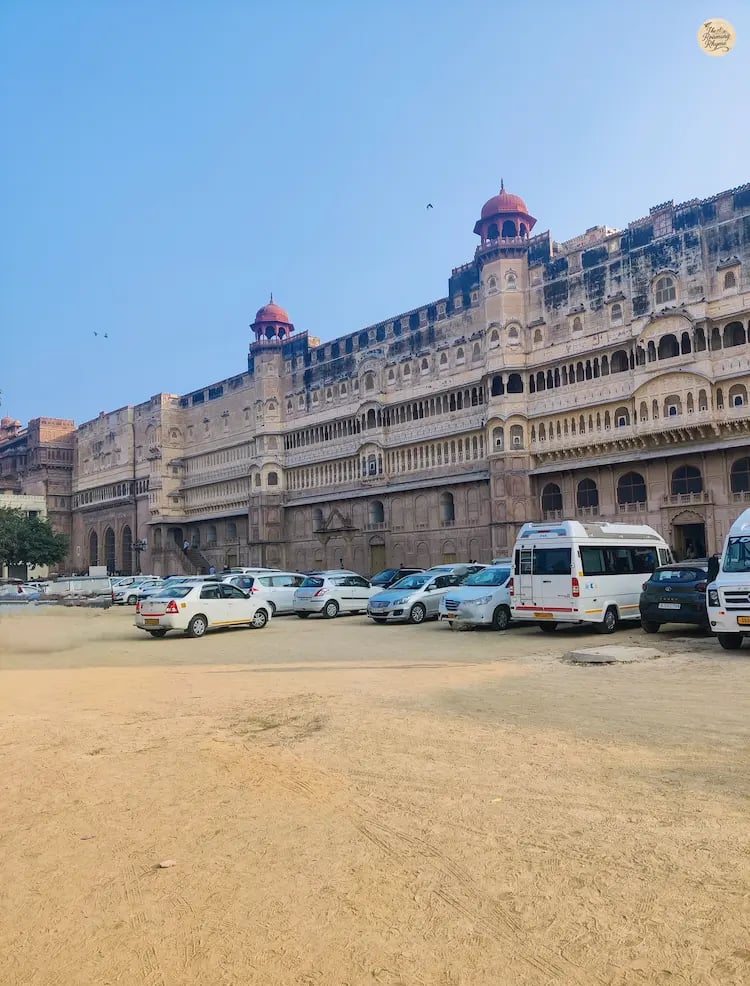

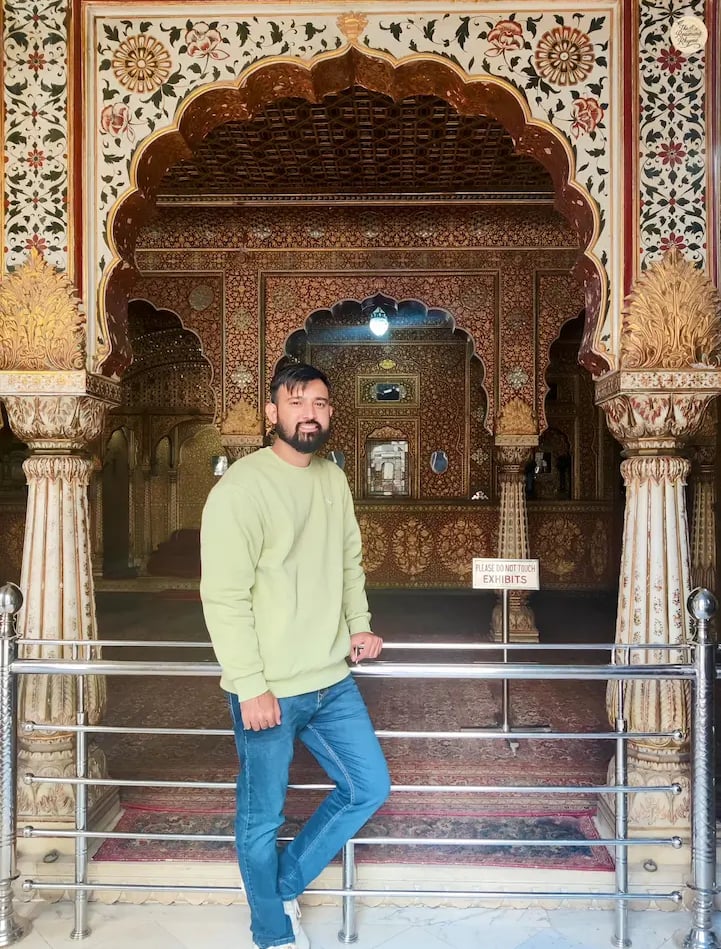

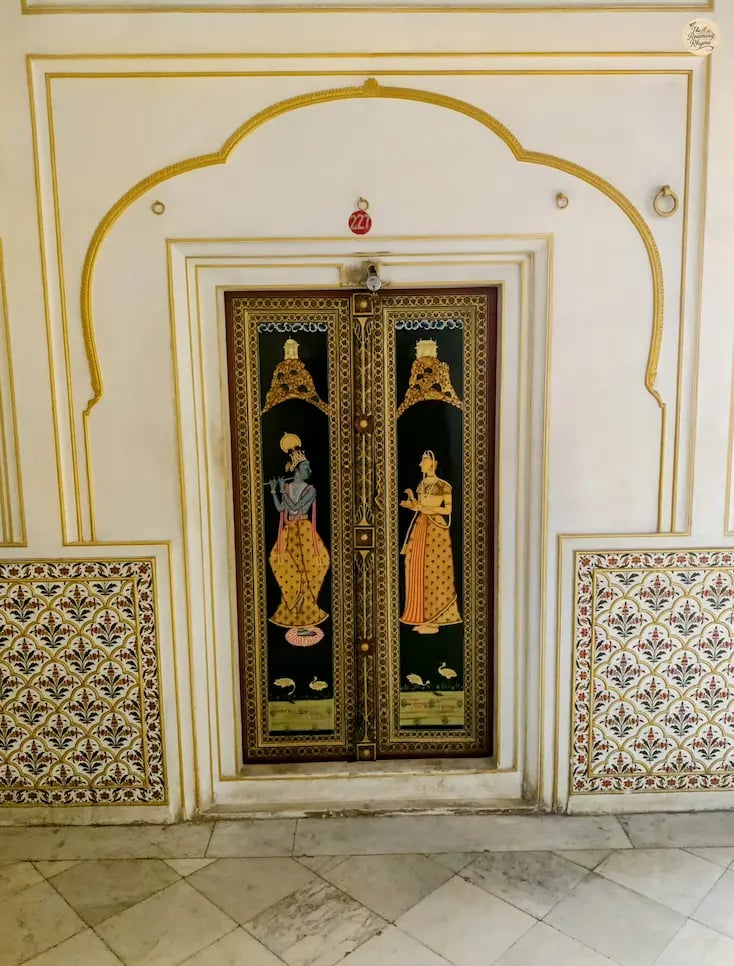

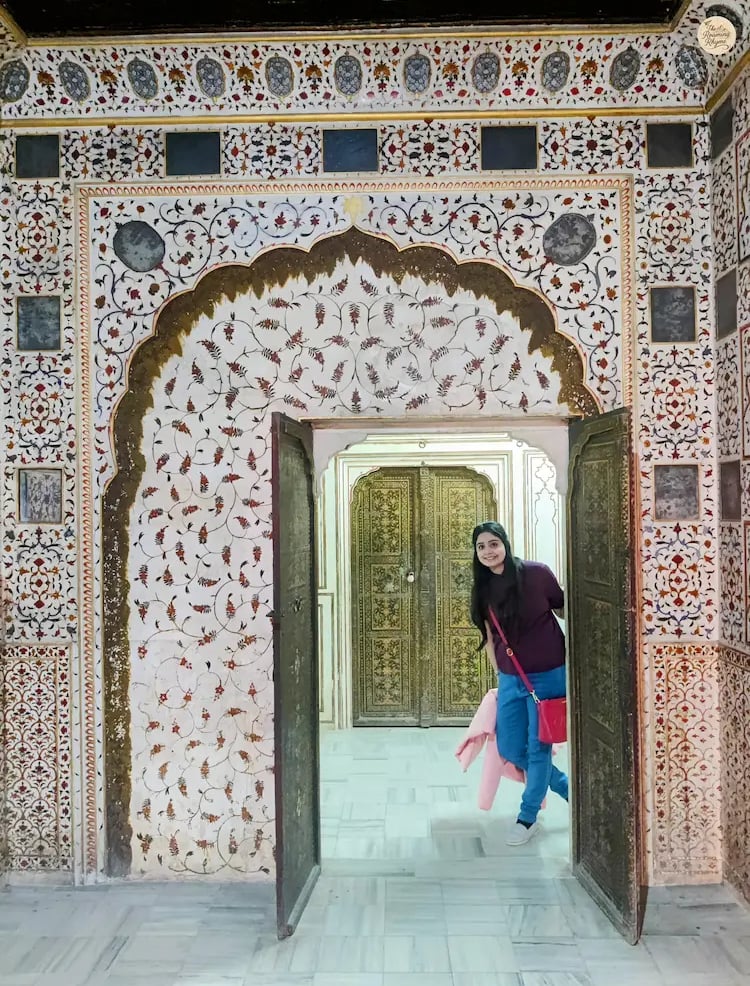

Phool Mahal — A symphony of color and craft in Bikaner’s regal past.
Step into Phool Mahal, where the walls still bloom with royalty.
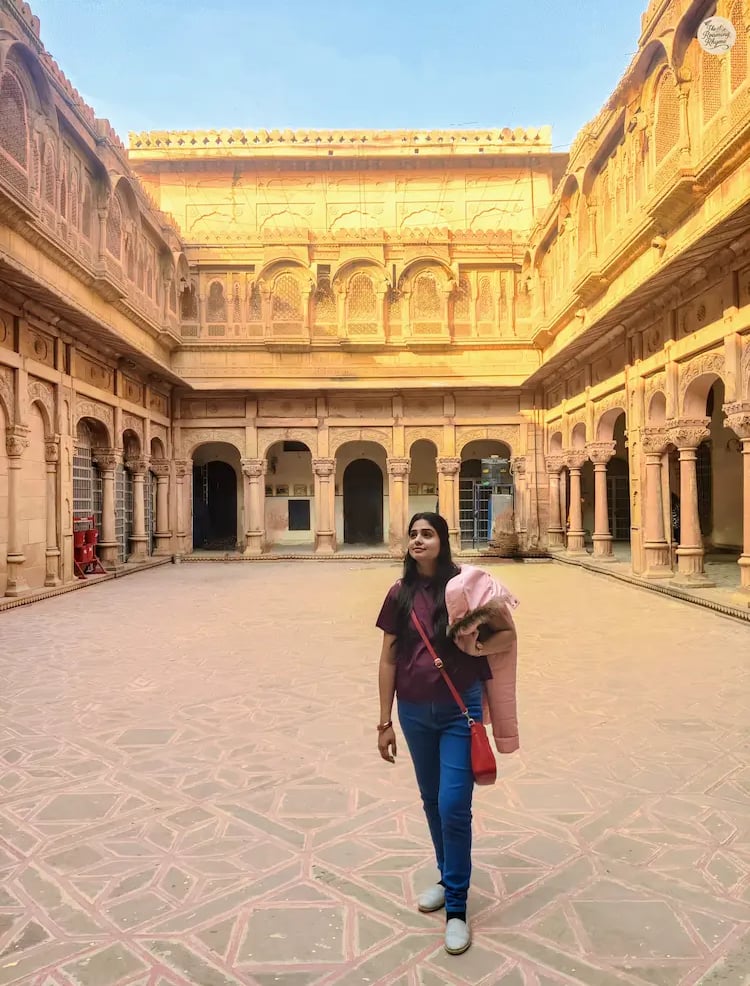

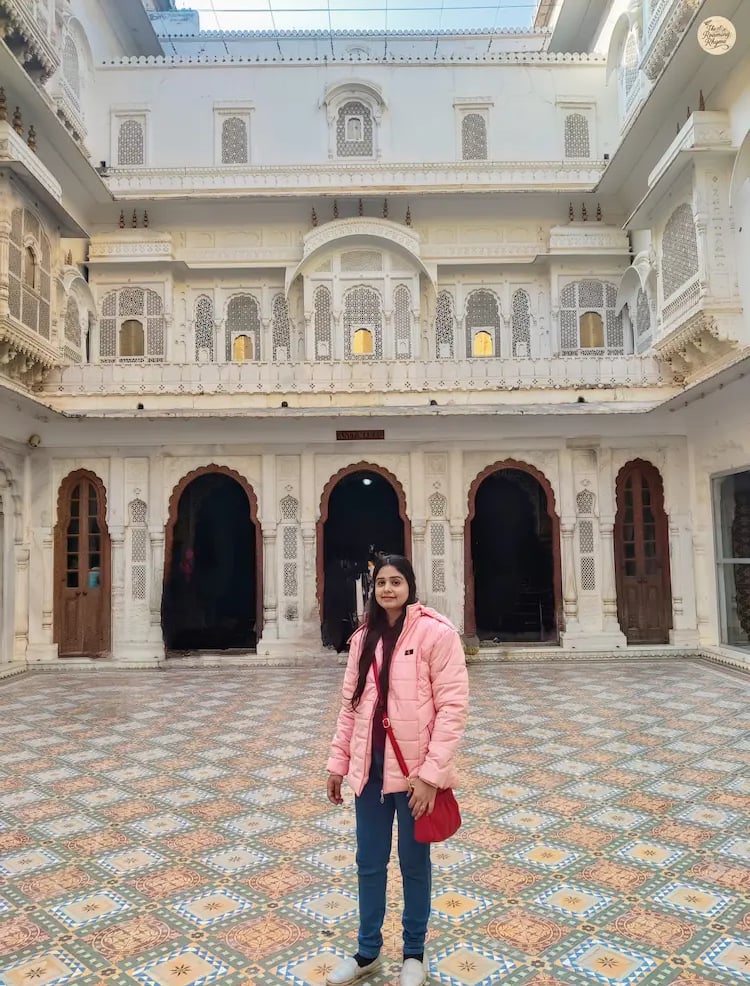

Majestic view of Junagarh Fort, showcasing its grand sandstone architecture.
A quiet courtyard where royal footsteps once echoed beneath open skies.
An open courtyard framing the calm beauty of Chandra Mahal.
Anup Mahal — Where gold gleams and royal stories echo through time.
Ganga Mahal – A 20th-century addition by Maharaja Ganga Singh, housing the Ganga Singh Hall museum, vintage weaponry, paintings, coins, and even a World War I biplane.
Chandra Mahal – Showcases royal luxury at its peak with gold-plated décor, mirrorwork, and gemstone-infused paintings. Clever mirror placements once served as ancient surveillance for the royals.
Badal Mahal (Palace of Clouds) – Famous for its rain-themed frescoes of Radha and Krishna, and paintings symbolizing devotion and endurance. A poetic conclusion to your exploration.
Each palace within Junagarh Fort tells a story of devotion, artistry, and royal grandeur. Walking through its halls is not just sightseeing—it’s stepping back into the regal world of Rajasthan’s history.
💡Travel Tip: Allocate at least 3–4 hours for a thorough visit. Hiring a local guide enriches the experience, as they share stories behind palaces, frescoes, and hidden details that you might otherwise miss.
Stroll, Shop, and Savor – Kote Gate Bazaar & Local Specialties of Bikaner
Keep your energy up for a late evening stroll and shopping spree through the bustling markets of Bikaner. If you start feeling low, a bite of Bikaneri bhujia or a juicy rasgulla will instantly refresh you. Begin your walk at Kote Gate Bazaar, a lively street running parallel to the railway line. Kote Gate itself is one of the historic gateways to the old city, blending history with modern-day commerce.
As the locals say, “Bikaner is a city where one half of the population is busy making bhujia, and the other half is busy eating it.” This sentiment comes alive as you wander through Kote Gate, home to famous bhujia brands like Bikaji, Bhikharam Chandmal, and Bishanlal Babulal—names synonymous with Bikaneri snacks.
For a unique experience, stop by Mool Sa Phool Sa, a charming paan stall run by a man in traditional Rajasthani attire, complete with a colorful safa and twirling moustache. His paan is a must-try and a perfect Instagram moment.
While exploring the bazaars, don’t miss locally crafted Nokha Rajai quilts, known for their warmth and lightness, or the vibrant Rajasthani sarees on display. Each item reflects Bikaner’s rich artisan heritage.
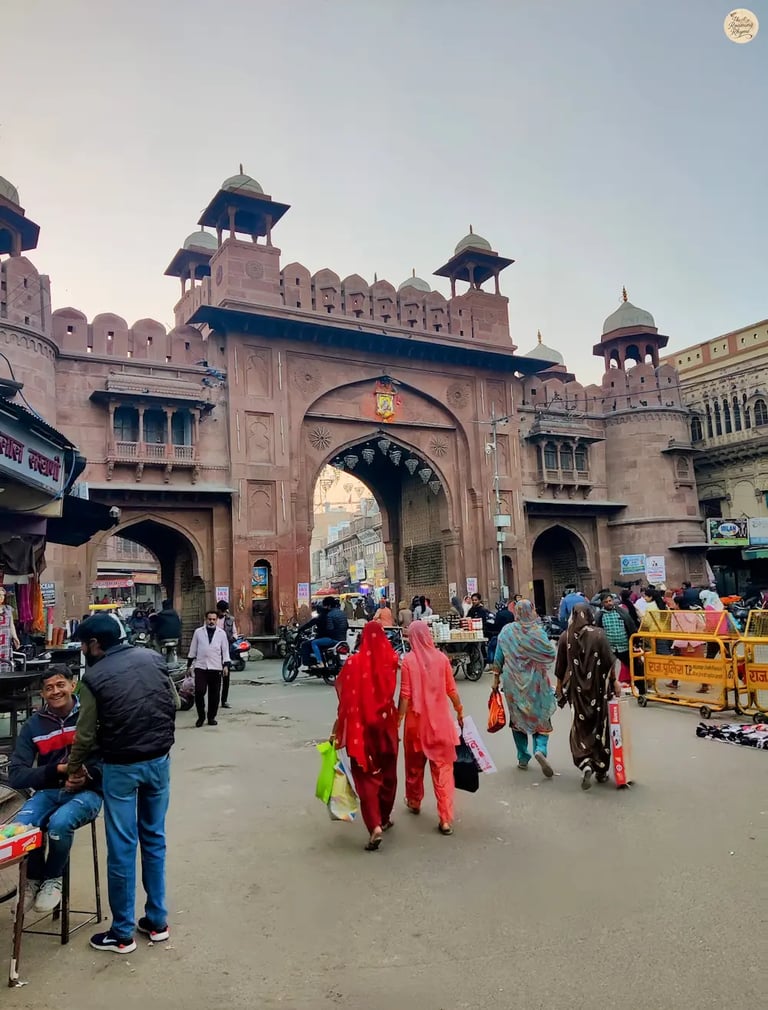

Street view of Kote Gate Bazaar, lined with traditional shops and local crowds.
Bikaner by night is quieter yet enchanting—the rustle of sarees, the chime of temple bells, and the crunch of the last bhujia bite linger in memory, making the city feel alive even after dark.
Sleep well—Day 2 promises curious turns, from rats in temples to sunsets over the desert dunes!
Bikaner Itinerary Day 2 – Offbeat Bikaner & Desert Soul
If Day 1 was a dance through palaces, havelis, and heritage-filled bazaars, Day 2 is about chasing the unusual—where divine legends, royal memories, and desert winds create their own rhythm. Today is about stories that don’t make it to postcards, but stay with you long after the journey ends. This is offbeat Bikaner, soulful and serene.
Come, let’s wander where tradition touches the surreal, and every stop writes a verse in the roaming rhyme of the desert.
Karni Mata Temple, Deshnok (Rat Temple)
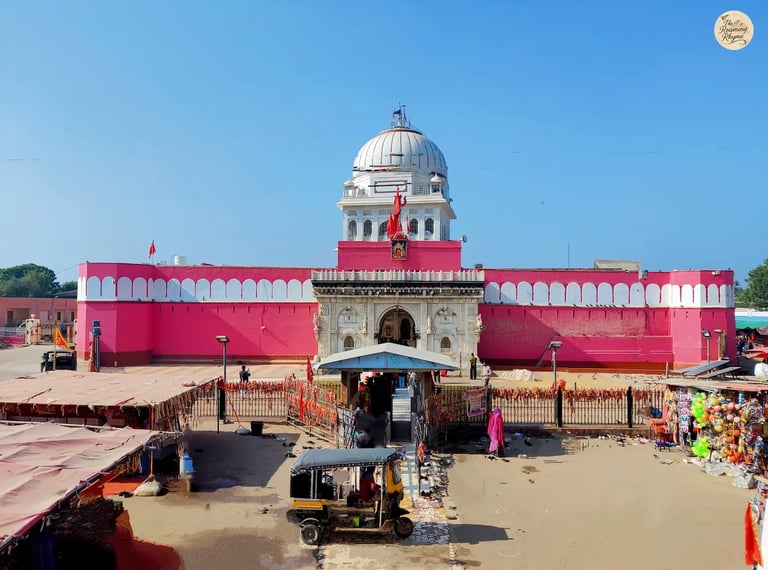

Karni Mata Temple, Deshnok — Rajasthan’s iconic Rat Temple, home to thousands of sacred rats.
After breakfast, drive 30 km south of Bikaner to the village of Deshnok, home to one of the world’s most unusual shrines: the Karni Mata Temple, famously known as the Rat Temple.
Dedicated to Karni Mata, a 14th-century mystic believed to be an incarnation of Goddess Durga, the temple houses over 20,000 sacred rats, known as kabbas. Spotting a rare white rat is considered extremely lucky, and if one scurries across your feet, it’s regarded as a blessing. Remarkably, even during historical plagues, Deshnok remained untouched. Devotees consider food nibbled by these rats as prasad, a sacred honor to consume.
Deshnok’s lanes are lined with small, no-frills eateries, each serving a slice of Rajasthani warmth. After your temple visit, pause for a local desert-inspired lunch—try Ker Sangri, a tangy-spiced desert berry dish, or Jodhpuri Gatta, a comforting specialty that tastes like tradition itself. Simple, soulful food that lingers long after the last bite.
💡Travel Tip: Visit Karni Mata Temple early in the morning to avoid crowds and experience the temple rituals in peace. Remove your shoes and consider wearing socks due to the temple's floor conditions. Photography is allowed, but be respectful of devotees.
NRCC Camel Research Centre – Ships of the Desert
After exploring the mystical charm of Deshnok, head back towards Bikaner city with a unique desert stop at the National Research Centre on Camel (NRCC). Located near Jorbeer, this government-run camel breeding farm is one of Asia’s largest camel centres and offers a fascinating insight into Rajasthan’s most iconic animal.
Spread over 2,000 acres, NRCC is home to over 400 camels. Established in 1984, the centre focuses on camel breeding, training, and research, supporting both the animals and the local communities that depend on them.
Visitors can stroll through camel enclosures, watch playful calves, and explore a small museum that highlights the role of camels in desert life. Don’t miss the souvenir shop, featuring camel leather goods, bone art, and quirky keepsakes. For a truly unique treat, try camel milk ice cream or a chilled camel milk drink—it’s a taste of the desert you won’t forget.
💡Pro Tip: Plan your visit around 3 PM, when the herd returns from their daily desert stroll. Watching nearly 400 camels march back across the desert is a spectacular sight and perfect for photography.
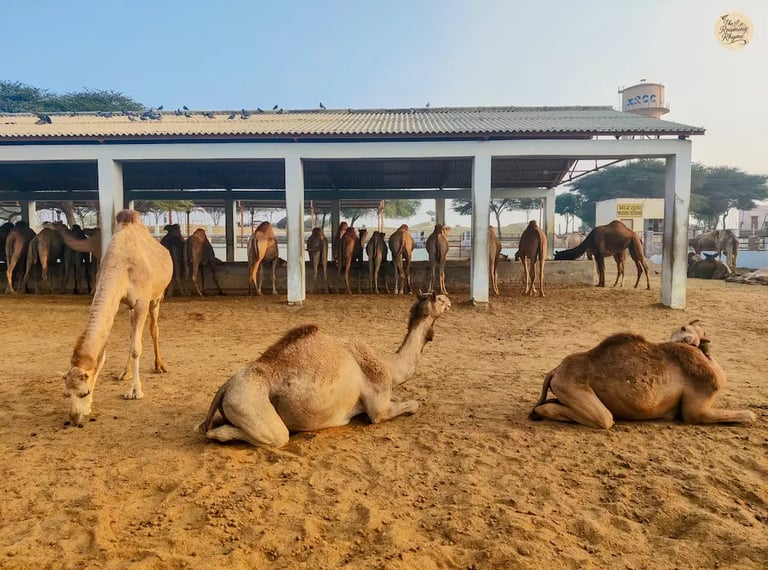

Meet the camels of NRCC, Bikaner — exploring the ship of the desert in their natural habitat.
Devi Kund Sagar Cenotaphs – Offbeat Heritage in Bikaner
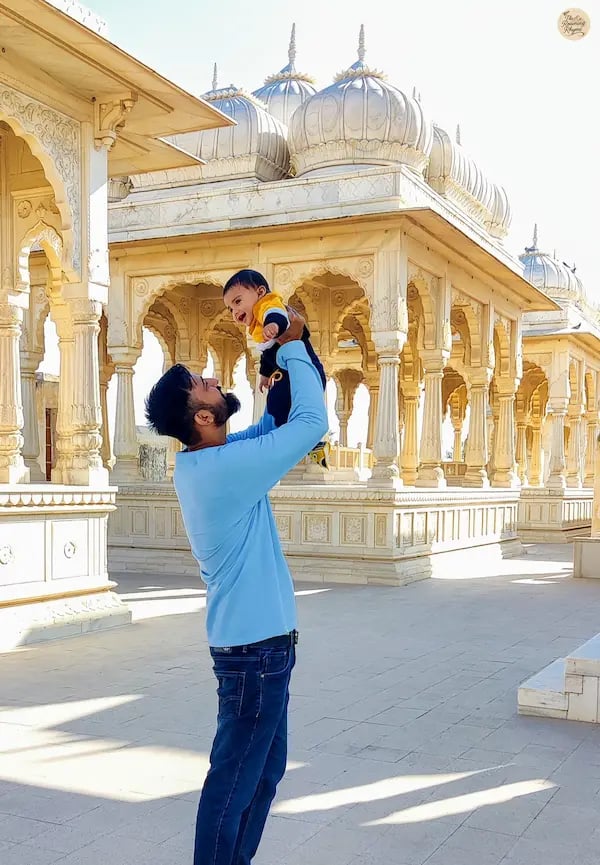

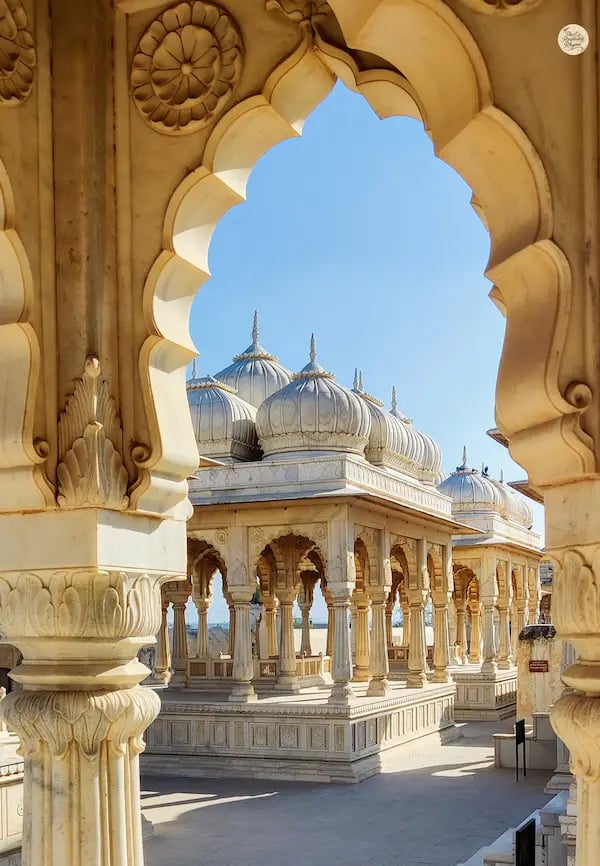

A peaceful moment with my toddler at Devi Kund Sagar — surrounded by marble chhatris of royal heritage.
Row of marble cenotaphs at Devi Kund Sagar — memorials of Bikaner’s kings and queens.
Before heading into the golden dunes of Raisar, take a moment to pause at Devi Kund Sagar in Bikaner—the city’s royal crematory that quietly tells the story of a proud Rajput legacy.
Built to honour Rao Bikaji, the founder of Bikaner, and his royal lineage, Devi Kund Sagar cenotaphs are striking examples of Rajasthani architecture. This memorial site houses an array of cenotaphs (chhatris), some carved from Dulmera red sandstone, others from gleaming white marble—each standing as a timeless tribute to the rulers who once shaped this desert kingdom.
As you wander through the memorials, you’ll find engraved inscriptions, detailed floral motifs, and faded yet graceful portraits—whispering tales of bravery, tradition, and royal life.
It’s a peaceful, reflective spot—beautifully offbeat in Rajasthan and steeped in history. A perfect short stop for lovers of architecture, heritage walks, photography, and art.
If cenotaph architecture fascinates you, you might also enjoy exploring the cenotaphs of Orchha in Madhya Pradesh, which echo a similar grandeur along the serene Betwa River.
Raisar Sand Dunes – Sunset & Desert Camp Experience
From the silence of stone at Devi Kund to the shifting sands of Raisar, the journey turns toward pure desert magic. Nestled near Bikaner City, Raisar Camp offers a slice of rustic Rajasthan wrapped in golden dunes and timeless charm.
The route itself is an experience—sandy trails pass untouched countryside, remote villages, and sun-drenched dunes that shimmer in the distance. Along the way, turbaned locals walk by, their silhouettes striking against the vast open sky. Keep an eye out for wildlife—antelopes, blue bulls, chameleons, desert foxes, and jackals—adding to the thrill of your desert adventure.
At the camp, the Thar Desert unfolds in full glory. Take a camel ride or hop onto a camel cart, feeling the slow, steady rhythm of the sand beneath your feet. For thrill-seekers, a jeep safari across the dunes lets you chase adventure over golden waves.
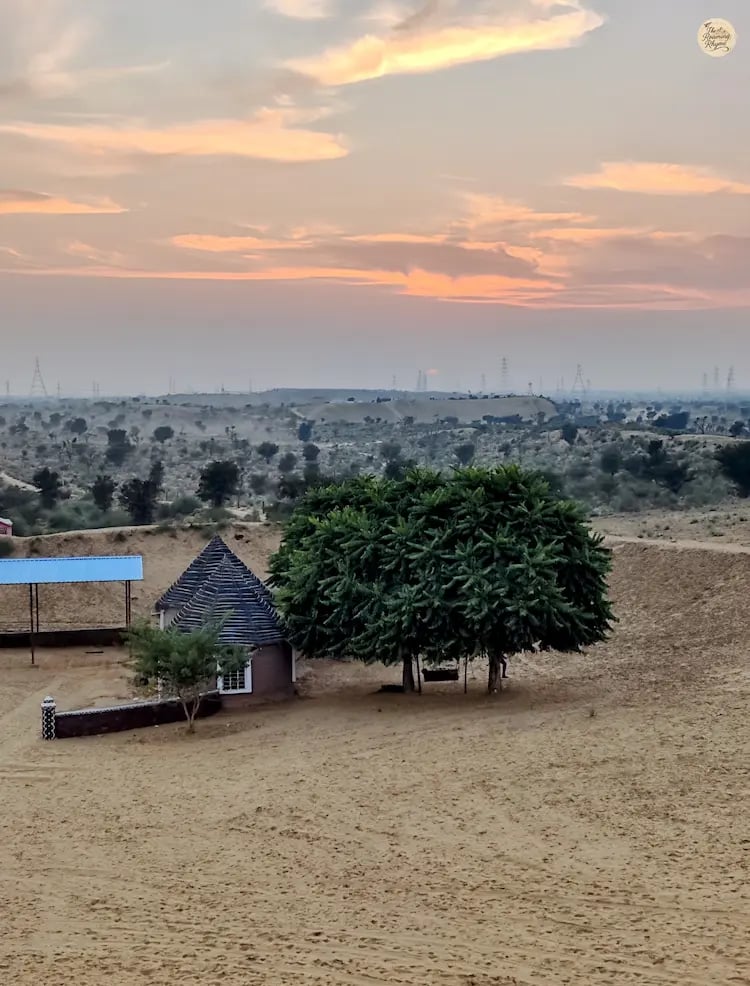

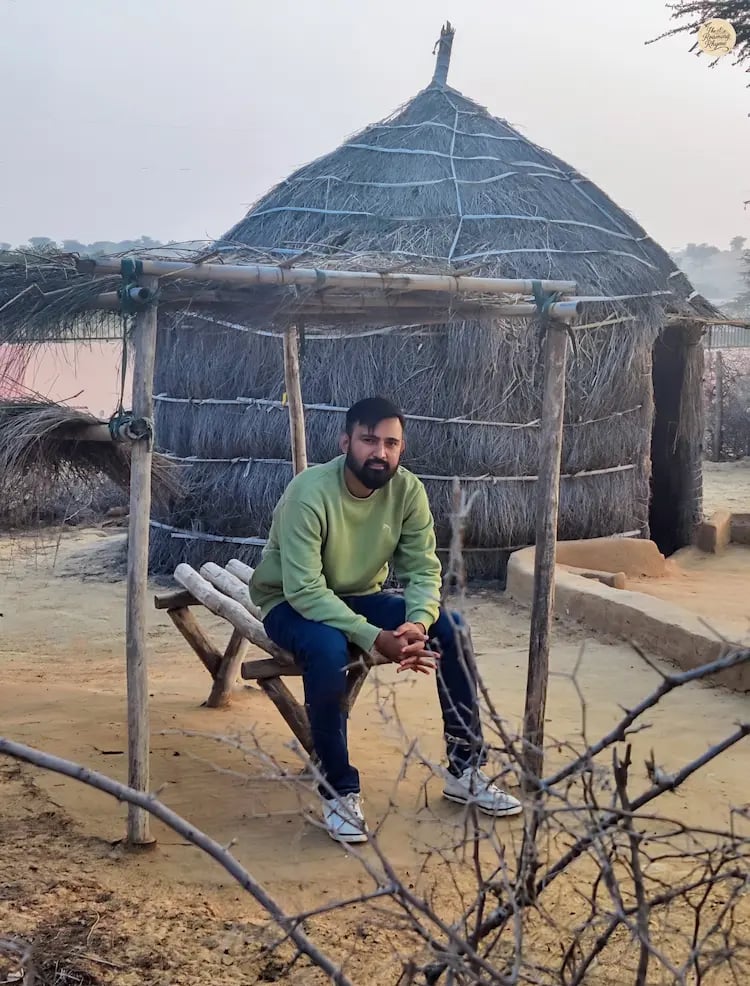

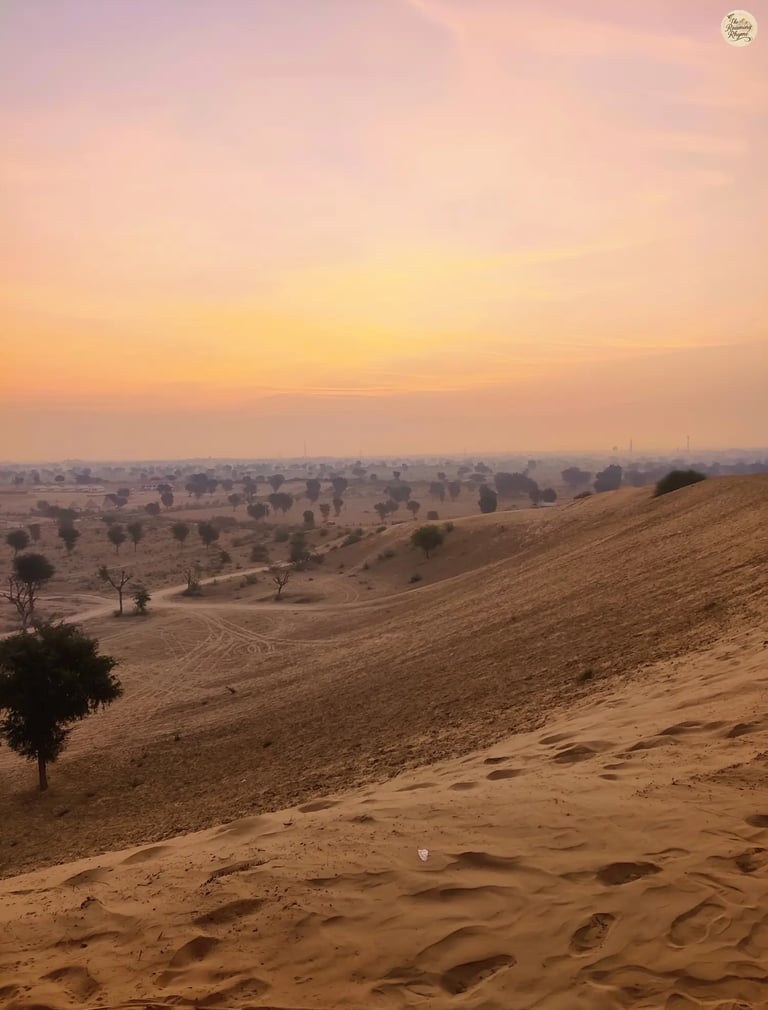

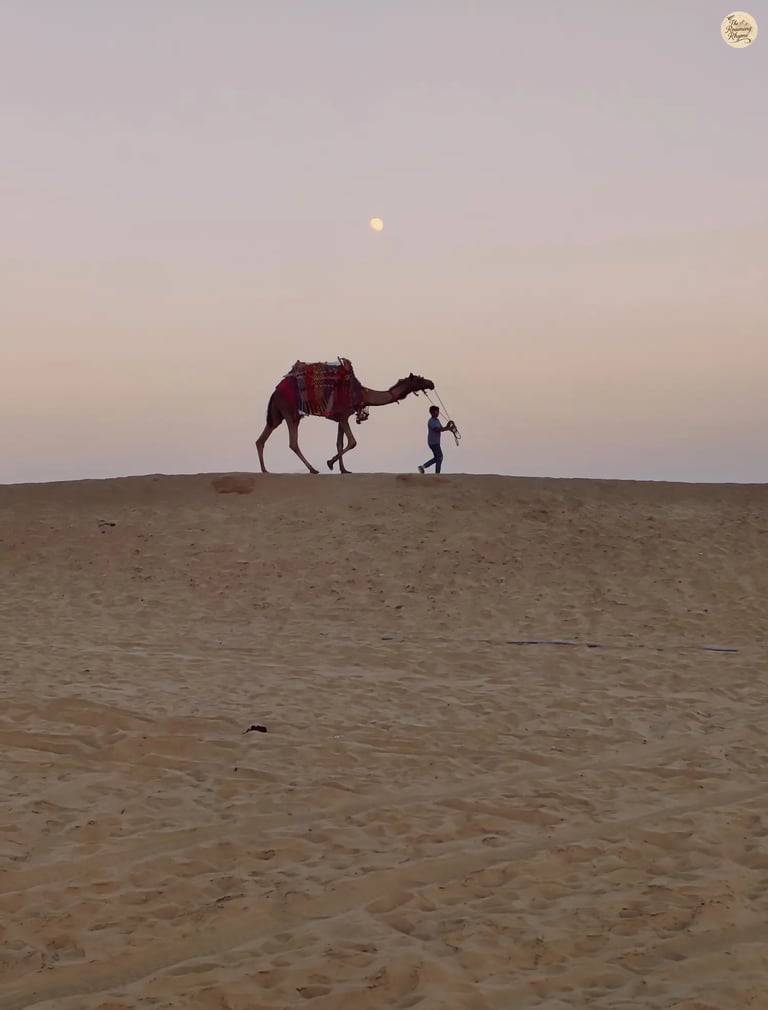

Sunset whispers over Raisar dunes - Bikaner's charming twilight tunes.
Raisar dunes blush in sunset's hue - Bikaner's golden hush in every view.
Sitting by a traditional Rajasthani hut in Raisar dunes - living the desert calm of Bikaner.
A camel in colorful attire walking through the Raisar dunes at dusk.
As dusk settles, the desert transforms. Village life, herds of cattle, and the wild charm of Rajasthan’s flora and fauna surround you. The true magic begins as you climb a sand dune, sit barefoot, and watch the sunset over Raisar. The sky turns pink, orange, and red, painting memories that linger long after.
When night falls, the desert comes alive with folk music, traditional dance, and a gala dinner by the campfire, accompanied by the soft desert breeze. Under the wide-open sky, you don’t just visit Raisar—you feel the Thar Desert.
Raisar isn’t just a place—it’s a peaceful escape and soulful journey into the heart of the Thar. As the sands settle and your journey ends, Bikaner leaves behind more than footprints—it leaves echoes.
You can check availability and book your stay on MakeMyTrip.
Bikaner is a visual delight for photographers, offering a perfect blend of heritage, culture, and desert landscapes.
Rampuria Haveli, with its rose-tinted sandstone, intricately carved windows, and frescoed courtyards, is a photographer’s paradise—especially in the soft morning light when the lanes are quiet. Junagarh Fort, the city’s architectural jewel, presents endless opportunities to capture royal palaces, mirrorwork halls, and ornate balconies that reflect Bikaner’s regal past.
For nature and landscape enthusiasts, the Raisar Sand Dunes provide magical moments at sunrise and sunset, where golden sands, camel silhouettes, and folk performances create unforgettable frames.
Other notable spots include the bustling Kote Gate Bazaar for vibrant street photography and Devi Kund Sagar for serene cenotaphs. Early morning and late afternoon light are ideal to bring out the city’s colors and textures vividly.
Best Photography Spots in Bikaner
This two-day escape wasn’t just about places to visit in Bikaner—it was about moments that linger. Junagarh Fort told tales in stone, while narrow lanes served up local Bikaneri food that danced on the tongue. Temples offered peace, bazaars overflowed with color, and the Raisar Desert Camp near Bikaner wrapped the day in golden stillness and soulful night songs.
If you’re searching for offbeat destinations in Rajasthan, let Bikaner surprise you. Here, camels and cenotaphs, bhujia and bhajans, sunsets and stories coexist under one sky. It may not always make the top-five Rajasthan list—but maybe that’s what makes it special.
Because in Bikaner, travel is not just sightseeing. It’s a feeling. A rhythm. A rhyme waiting to be traced—on every grain of sand, every whispering wall, every folk tune rising with the desert wind.
So, when you next plan a journey across Rajasthan’s cultural map, don’t just pass by Bikaner. Pause. Listen. Explore.
Let the Roaming Rhyme guide you through a city that doesn’t shout, but sings.
Frequently Asked Questions – Bikaner Travel Guide
Q. Why is Bikaner famous for?
A. Bikaner is known for its royal heritage, magnificent forts, havelis, sweets like Ghewar, and the famous Bikaneri bhujia. It’s also well known for Sand Dunes and Camel Safari.
Q. What food is famous in Bikaner?
A. Must-try foods include Bikaneri bhujia, Ghewar, Dal-Baati-Churma, Ker Sangri, Jodhpuri Gatta, and street food from the lanes like Mawa Patti and Chai Patti.
Q. Is Bikaner worth visiting?
A. Absolutely! Beyond its food, Bikaner offers majestic forts, heritage havelis, colorful bazaars, temples, and desert experiences, making it a unique Rajasthan destination.
Q. What is the best time to visit Bikaner?
A. The best time is October to March (winter) for pleasant weather. January is ideal if you want to experience the Camel Festival.
Q. How many days are sufficient for Bikaner?
A. A 2-day itinerary covers the main attractions, heritage walks, local cuisine, temples, and desert experiences comfortably.
Q. Which rat temple is famous in Bikaner?
A. The Karni Mata Temple in Deshnok is the world-famous rat temple near Bikaner.
Q. How far is Karni Mata Temple from Bikaner?
A. The Karni Mata Temple in Deshnok is about 30 km south of Bikaner, approximately a 45-minute drive.
Q. What is the Karni Mata Temple famous for?
A. It is famous for over 20,000 sacred rats, believed to be reincarnations of Karni Mata’s devotees. Seeing a white rat is considered especially lucky.
Q. Can visitors experience a camel safari in Bikaner?
A. Yes! Camel safaris are available at Raisar Dunes and desert camps near the city, offering sunset rides and jeep-camel experiences.
Q. How much is the camel safari in Bikaner?
A. Camel rides typically cost around INR 300–1000 per person, depending on the duration and type of safari.
Q. Why is Bikaner known as Camel Country?
A. Bikaner is called Camel Country because the city boasts of some of the world's best riding camels, and it is also home to one of the world's largest camel research and breeding farms.
Q. How far is the desert from Bikaner?
A. The main desert dunes, like Raisar, are about 45–50 minutes from the city center, easily accessible by car or guided tour.
Q. What to shop for in Bikaner?
A. Shop for Nokha Rajai (quilts), Rajasthani sarees, handicrafts, camel leather goods, and local sweets in markets like Kote Gate Bazaar.
Share Your Thoughts – We’d Love to Hear From You!
Every journey is better when shared.
We hope you enjoyed this travel story — now, we'd love to hear yours! Share your experience, suggestions, or feedback and help us make our travel tales even better.
